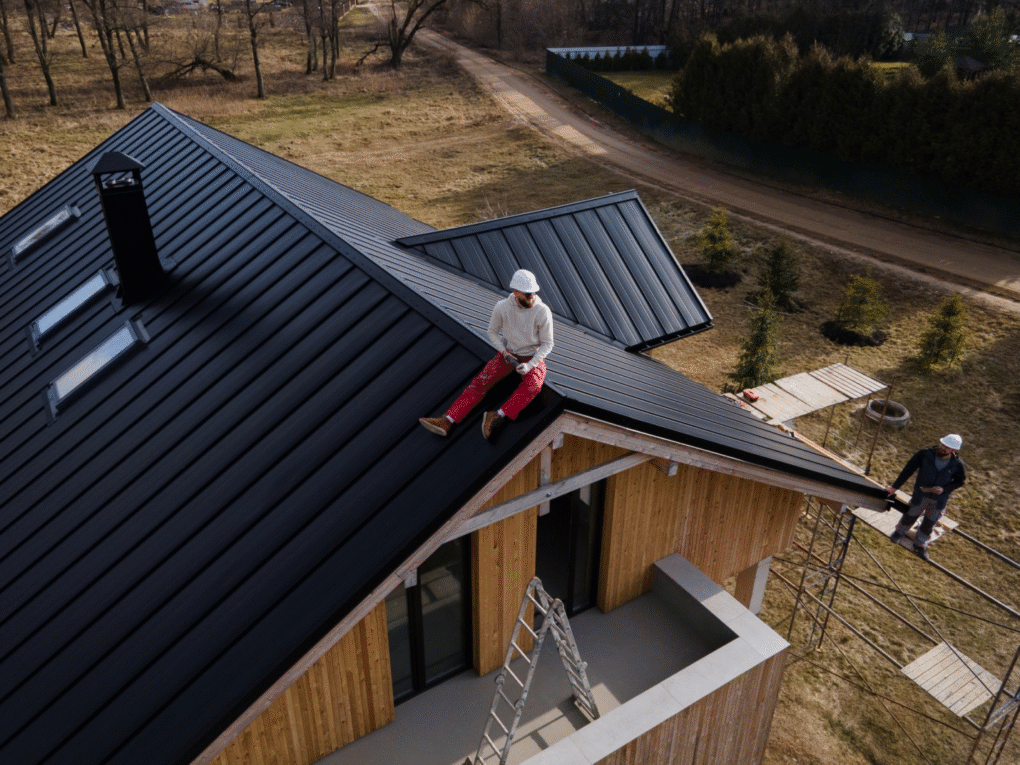One of the most hazardous jobs is still roofing; according to statistics, falls are the cause of more than 79% of roofing fatalities in the US, with a fatality rate ten times higher than the average for all construction jobs. However, you can safeguard the workers and lower on-site risks with careful planning and regular safety procedures.

1. Pre-Start Debriefing:
Before somebody even climbs a ladder, every safeguarded roofing job gets started. A pre-start debriefing, which is also called a toolbox talk or safety briefing, is an important step in making sure that everyone on the team knows the potential hazards, duties, and safety rules for the job site. Whether you’re a seasoned Kona roofer or a new crew member, this short but organized talk sets the tone for the day’s work, helps avoid confusion, and makes sure that everyone is ready to work safely in both mind and body.
- A comprehensive safety briefing must be given before the start of any roofing work, no matter how straightforward or standard. Talk about this for at least ten minutes.
- There are certain risks (such as exposed edges, electrical wires, and weak roof spots).
- Equipment to be utilised, along with the proper methods for attachment and inspection Environmental and weather hazards (wind, cold, and heat)
- Such a shared understanding diminishes the risk of miscommunication and guarantees that a crew member can be on the lookout for certain things.
2. Keep All Ropes, Cords, and Tools out of Passing Areas
Tripping incidents caused by ropes, cords, or tools are among the leading incidents of falling, mostly when working on sloped or unstable roof surfaces.
- Run extension cords and ropes away from working paths
- Coil off any excessive length and secure them so they do not fall beyond the roof edge
- Keep power tools in designated areas, away from any execution paths
- A clear worksite improves safety and maintains good footing and balance at heights.
3. Guardrails and Personal Fall Protection Systems
Fall protection is mandatory and must be enforced when working at heights.
Two of the most efficient protection systems are:
- Guardrail Systems: Should be installed on all open edges of the roof and openings. A guardrail should consist of a top rail, set 39–45″ above the working surface, and a mid-rail and be capable of resisting 200 pounds of force applied to it.
- Personal Fall Arrest Systems (PFAS): Comprise body harnesses, anchors, and lanyards. Anchors must hold 5,000 pounds of weight at a minimum; lanyards are intended to limit free fall to six feet or less, with deceleration to last no longer than 3.5 feet.
4. Use Clear Signage to Control the Area
Roofing premises are dangerous not just for those who are working, but also for anyone who is close by, such as other contractors, residents, or people who are just passing by. Using clear, easy-to-see signs is one of the easiest and most effective ways to keep accidents from happening. Proper signs warn people of danger, keep people who shouldn’t be there out, and help them move safely around the work zone. By marking dangerous areas, entry points, and equipment zones ahead of time, you make it clear to everyone, from crew members to the general public, what the rules are and how to act. conspicuous signage:
- To warn against: “DANGER – Keep Off Roof”
- To restrict access: “Access By Permit Only”
- To caution: “Roof Slippery When Wet”
These signs give a clear message to avoid confusion, limit unauthorized entries, and create a conscious reminder for the crew.
Learn About Common Roof Hazards
It is these safety rules that exist because roof workers are exposed to a variety of hazards:
- Fall Hazards: Roof edges, cracks, holes, and weak structural spots, common risk zones that require guardrails and harnesses.
- Power Tools: Misuse of electric tools, as well as improperly routed cords, can present hazards in the form of trips, cuts, and shocks.
- Electricity: Lines and conductors overhead within the near vicinity of the work area may produce shocks or electrocution when not properly dealt with.
- Hazardous Materials: Paints, adhesives, chemicals, and fumes thereof demand handling safety and proper PPE ().
- Extreme Temperatures: Roofing under blazing sun or freezing conditions may lead to heatstroke, burns, or hypothermia, giving rise to proper footwear and hydration breaks.
Beyond the Basics: Roofing Safety Best Practices
Edge Protection: Permanent or temporary guardrails are essential, mainly on residential and commercial roofs; they usually include toe boards and midrails.
Ladder Safety: Ladders should be inspected before use. Assure that they are secure, and set on firm and even ground. Maintain an angle of 1 foot out for every 4 feet up.
Training & Familiarity With Tools: Every worker should be trained to use equipment such as harnesses, anchors, ladders, and power tools, and must do so safely and effectively. Supervisors should reinforce this during regular toolbox talks.
Safety Is Everyone’s Responsibility
Everyone Has a Responsibility to Ensure Safety In addition to hurting employees, roofing mishaps cause delays in projects, raise expenses, and expose your team to legal risks. Make safety a top priority as a team leader or supervisor:
- Give a thorough safety briefing and documentation at the beginning of each day. Keep workspaces neat.
- For fall protection, combine guardrails with PFAS. Mark off restricted areas clearly so that everyone is aware of them.
These steps are crucial, even for owners performing a do-it-yourself roof project. Rooftop jobs can be secure, efficient, and incident-free with the correct safety measures, training, and constant attention to detail.
Conclusion:
The most effective way to prevent roofing injuries is to adhere to these four important guidelines: pre-start debriefs, clear workspaces, guardrails and harnesses, and effective signage. You must additionally be conscious of common hazards. You safeguard your crew, your project, and your peace of mind by making a daily commitment to safety.
